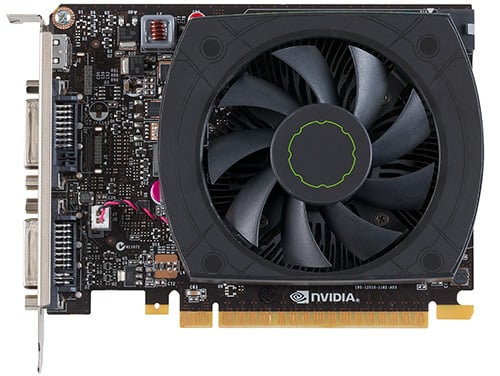NVIDIA GeForce GTX 650 Ti Round-Up: EVGA, ZOTAC, GB
Introduction and Specifications
NVIDIA has been on a tear as of late, releasing a constant stream of GPUs over the last few weeks. In mid-August, the GPU giant released the GeForce GTX 660 Ti and less than a month later, followed up with the GeForce GTX 660 and GeForce GTX 650. Here we are now, less than a month since that release and NVIDIA is at the ready again with yet another new GPU called the GeForce GTX 650 Ti.
As its name implies, the GeForce GTX 650 Ti is a step up from the standard “non-Ti” GeForce GTX 650. The new GeForce GTX 650 Ti, however, isn’t powered by the same GPU as the GTX 650. Whereas the GeForce GTX 650 has a GK107 GPU at its heart, the new GeForce GTX 650 Ti uses the same GK106 as the higher-end GTX 660 series cards, albeit with a few blocks of the chip disabled. The end result is a card that’s much more powerful than the standard GeForce GTX 650, but is priced only slightly higher.
Take a gander at the specifications and reference card below and we’ll follow up with a look at a trio of custom GeForce GTX 650 Ti cards from a few of NVIDIA’s board partners and a full performance profile on the pages ahead…

NVIDIA GeForce GTX 650 Ti Reference Card.
|
| Processing Units | |
| Graphics Processing Clusters | 2 or 3 |
| SMXs | 4 |
| CUDA Cores | 768 |
| Texture Units | 64 |
| ROP Units | 16 |
| Clock Speeds | |
| Base Clock | 925 MHz |
| Boost Clock | N/A |
| Memory Clock (Data Rate) | 5400 MHz |
| L2 Cache Size | 256KB |
| Memory | |
| Total Video Memory | 1024MB or 2048MB |
| Memory Interface | 128-bit |
| Total Memory Bandwidth | 86.4 GB/s |
| Texture Filtering Rate (Bilinear) | 59.2 GigaTexels/sec |
| Physical & Thermal | |
| Fabrication Process | 28 nm |
| Transistor Count | 2.54 Billion |
| Connectors | 2 x Dual-Link DVI, 1 x Mini HDMI |
| Form Factor | Dual Slot |
| Power Connectors | 1 x 6-pin |
| Recommended Power Supply | 400 watts |
| Thermal Design Power (TDP) | 110 watts |
| Thermal Threshold | 98° C |
Like the GeForce GTX 660, the new GeForce GTX 650 Ti is based on the GK106 GPU. Although the GK106 features all of the same technology as NVIDIA’s more powerful Kepler-based graphics processors, this GPU is somewhat smaller and scaled-down versus its higher-end counterparts.

GK106: GeForce GPU Block Diagram (Note - One SMX is Disabled on the GTX 650 Ti)
Here is a high-level block diagram of the GK106 GPU powering the GeForce GTX 650 Ti. The actual chips are manufactured using TSMC’s 28nm process node and are comprised of approximately 2.54B transistors. In its full configuration, the GPU features three Graphics Processing Clusters (GPC) with three SMXs and a total of 960 CUDA cores arranged in 5 SMXs. There are also 80 texture units and 24 ROPs within the GPU, along with 384K of L2 cache. On the GeForce GTX 650 Ti, however, one of the SMXs has been disabled, which results in a total of 768 active CUDA cores, with 64 texture units, 16 ROPs and 256K of L2 cache.
A memory partition on the GK106 has also been disabled on the GeForce GTX 650 Ti. Instead of the GTX 660's 192-bit interface, memory on the GTX 650 Ti is linked to the GPU via a 128-bit interface. In comparison to the GeForce GTX 660, the new 650 Ti has less cache, a narrower memory interface, and fewer CUDA cores, texture units, and ROPs, which results in lower compute performance, fillrate, and memory bandwidth.
Some Pics of the NVIDIA GeForce GTX 650 Ti Reference Card.
NVIDIA’s reference specifications call for a base GPU clock of 928MHz on the GeForce GTX 650 Ti, 1GB of memory, and memory clock of 1350MHz (5400MHz effective). At those frequencies, GeForce GTX 650 Ti card will offer up to 86.4GB/s of memory bandwidth and 59.2GTexes/s of textured fillrate. Many of NVIDIA’s partners, however, are ready with factory overclocked models (which we’ll show you on the next page), that will offer somewhat higher performance characteristics. Many cards from NVIDIA's partners will also feature 2GB frame buffers, instead of the 1GB of the reference card.
The GeForce GTX 650 Ti has a TDP of 110 watts and requires a single, supplemental 6-pin PCI express power feed. Cards are two-slot wide, but sport a short 5.65" PCB. The output configuration consists of 2 x DVI outputs and 1 mini-HDMI output, but the GPU supports up to four independent displays, so some parts may release cards with four outputs as well.






